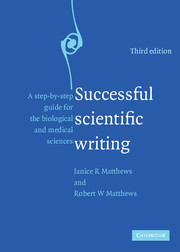Book contents
- Frontmatter
- Contents
- Preface
- Preface to the third edition
- 1 PREPARING TO WRITE
- 2 COMPOSING A FIRST DRAFT
- 3 VISUAL SUPPORT FOR THE WRITTEN WORD
- 4 VISUAL SUPPORT FOR THE SPOKEN WORD
- 5 REVISING TO INCREASE COHERENCE
- 6 IMPROVING WORD CHOICE, AND SYNTAX STYLE
- 7 ATTENDING TO GRAMMAR, NUMBERS, AND OTHER MECHANICS
- 8 THE REST OF THE STORY
- Appendix 1 Suggested responses to exercises
- Appendix 2 Excerpts from “Uniform requirements for manuscripts submitted to biomedical journals: Writing and editing for biomedical publication”
- Selected resources
- Index
3 - VISUAL SUPPORT FOR THE WRITTEN WORD
- Frontmatter
- Contents
- Preface
- Preface to the third edition
- 1 PREPARING TO WRITE
- 2 COMPOSING A FIRST DRAFT
- 3 VISUAL SUPPORT FOR THE WRITTEN WORD
- 4 VISUAL SUPPORT FOR THE SPOKEN WORD
- 5 REVISING TO INCREASE COHERENCE
- 6 IMPROVING WORD CHOICE, AND SYNTAX STYLE
- 7 ATTENDING TO GRAMMAR, NUMBERS, AND OTHER MECHANICS
- 8 THE REST OF THE STORY
- Appendix 1 Suggested responses to exercises
- Appendix 2 Excerpts from “Uniform requirements for manuscripts submitted to biomedical journals: Writing and editing for biomedical publication”
- Selected resources
- Index
Summary
Art, like morality, consists of drawing the line somewhere.
– G. K. ChestertonWhether or not one is prepared to call them art, visual aids can be vitally important in presenting a scientist's message. They summarize and emphasize key points and reduce narrative length. They simplify information, and in this way enhance understanding. They improve the conciseness and clarity of the narrative. And finally, when carefully crafted, they add visual appeal.
Visual material supports the printed message. Picking up a classic research paper, scientists often scan graphics such as tables and figures to see whether the rest of a paper is worth reading. While they may not go on to study every sentence, they almost always look at every illustration. For this reason, each visual aid must contribute an essential part to the written or spoken story, and each must be capable of standing on its own without reference to the text.
For two major reasons, it pays to start preparing visual aids as early as possible in the writing process. First, because tables and figures present data in condensed form and help clarify and support ideas, they make writing easier. Second, sooner than you think, you'll be asked to give an oral presentation on your research. While the visual aids for a written document seldom are suitable for direct transfer into a slide presentation, they undeniably will form the basis for that presentation.
In this chapter, we'll present guidelines for various types of graphic aids for the traditional research paper.
- Type
- Chapter
- Information
- Successful Scientific WritingA Step-by-Step Guide for the Biological and Medical Sciences, pp. 56 - 78Publisher: Cambridge University PressPrint publication year: 2007
- 1
- Cited by



